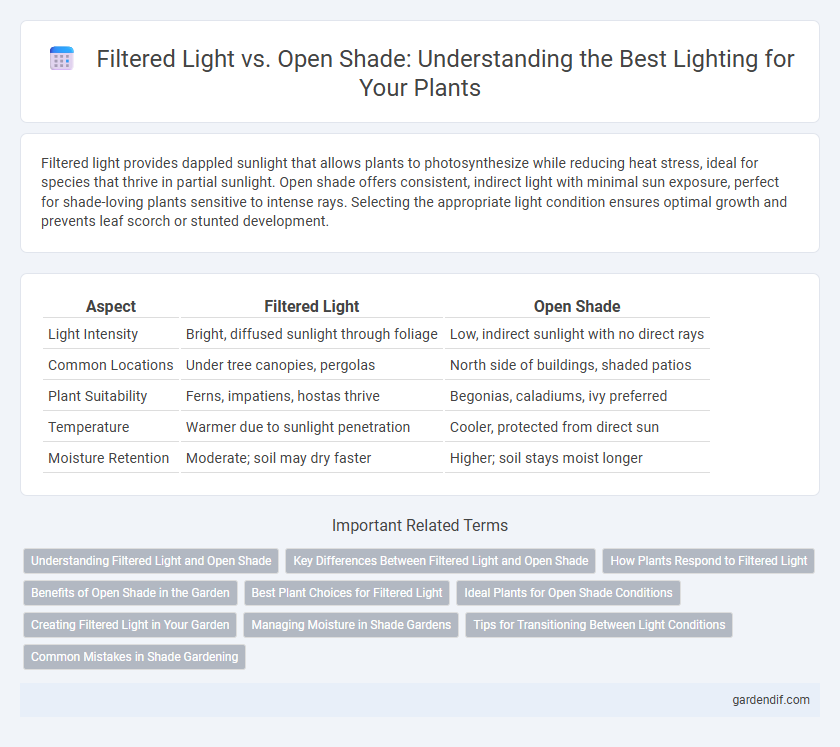
Filtered Light vs Open Shade Illustration
Filtered light provides dappled sunlight that allows plants to photosynthesize while reducing heat stress, ideal for species that thrive in partial sunlight. Open shade offers consistent, indirect light with minimal sun exposure, perfect for shade-loving plants sensitive to intense rays. Selecting the appropriate light condition ensures optimal growth and prevents leaf scorch or stunted development.
Table of Comparison
| Aspect | Filtered Light | Open Shade |
|---|---|---|
| Light Intensity | Bright, diffused sunlight through foliage | Low, indirect sunlight with no direct rays |
| Common Locations | Under tree canopies, pergolas | North side of buildings, shaded patios |
| Plant Suitability | Ferns, impatiens, hostas thrive | Begonias, caladiums, ivy preferred |
| Temperature | Warmer due to sunlight penetration | Cooler, protected from direct sun |
| Moisture Retention | Moderate; soil may dry faster | Higher; soil stays moist longer |
Understanding Filtered Light and Open Shade
Filtered light refers to sunlight that passes through a translucent barrier such as tree leaves, creating a dappled pattern that provides plants with moderate, diffused illumination ideal for species that thrive without direct sun exposure. Open shade is an area shielded directly from sunlight by large objects or structures, offering consistently low light levels suited for shade-loving plants that cannot tolerate even gentle sun. Understanding the nuances between filtered light and open shade is crucial for gardeners to select appropriate plants and optimize growth conditions based on light intensity and duration.
Key Differences Between Filtered Light and Open Shade
Filtered light offers partial sunlight filtered through tree leaves or other structures, providing dappled illumination that supports plants needing moderate light levels. Open shade receives no direct sunlight but benefits from ambient or reflected light, ideal for shade-tolerant species requiring low light conditions. The key difference lies in light intensity and quality, with filtered light delivering brighter, diffuse rays and open shade maintaining consistently lower luminosity.
How Plants Respond to Filtered Light
Filtered light provides partial sunlight that enhances photosynthesis without causing leaf scorch, fostering healthier growth in shade-tolerant plants such as ferns, begonias, and calatheas. Plants under filtered light exhibit increased chlorophyll production, leading to richer foliage color and improved nutrient absorption compared to open shade. This light condition supports optimal plant development by balancing light intensity and temperature, reducing stress and promoting robust, vibrant growth.
Benefits of Open Shade in the Garden
Open shade provides a balanced environment with filtered sunlight that reduces heat stress on plants, promoting healthier growth and vibrant foliage. It minimizes the risk of leaf scorch and water loss, ensuring plants retain moisture more effectively. This type of shade is ideal for shade-tolerant species, enhancing biodiversity and creating a comfortable microclimate for garden visitors.
Best Plant Choices for Filtered Light
Best plant choices for filtered light include ferns like Boston fern, shade-tolerant flowering plants such as impatiens and begonias, and tropical foliage plants like calatheas and philodendrons. These species thrive under dappled sunlight, which penetrates through trees or sheer coverings, providing the perfect balance of light without direct sun exposure. Selecting plants adapted to filtered light conditions promotes healthier growth, vibrant foliage, and extended blooming periods.
Ideal Plants for Open Shade Conditions
Ideal plants for open shade conditions include hostas, ferns, and astilbes, which thrive in low-light environments while providing lush foliage and seasonal flowers. These plants tolerate indirect sunlight and cooler temperatures, making them perfect for garden areas blocked by trees or structures. Selecting species suited to open shade ensures healthier growth and vibrant garden aesthetics without the risk of leaf scorch or stress caused by filtered light.
Creating Filtered Light in Your Garden
Creating filtered light in your garden involves strategically placing plants or structures that allow sunlight to pass through gently, mimicking natural canopy effects. Use light-permeable materials such as lattice panels, shade cloth, or deciduous trees with sparse foliage to diffuse harsh sunlight, fostering a favorable environment for shade-loving plants. Filtered light balances sunlight and shade, promoting healthier growth by preventing leaf scorch while ensuring sufficient photosynthesis.
Managing Moisture in Shade Gardens
Filtered light areas typically have better air circulation and allow for moderate moisture evaporation, reducing the risk of fungal diseases in shade gardens. Open shade tends to retain more moisture due to limited sunlight and airflow, requiring careful monitoring to prevent waterlogging and root rot. Proper soil drainage and mulching practices are essential to maintaining optimal moisture levels in both filtered light and open shade environments.
Tips for Transitioning Between Light Conditions
Transitioning between filtered light and open shade requires gradually acclimating plants to prevent stress or leaf burn. Start by placing plants in dappled sunlight for a few hours daily, increasing exposure time over one to two weeks. Monitor moisture levels closely since filtered light often retains more humidity compared to the drier conditions of open shade.
Common Mistakes in Shade Gardening
Many gardeners confuse filtered light with open shade, leading to improper plant placement and poor growth. Filtered light provides dappled sun through tree canopies, ideal for plants like ferns and hostas, while open shade receives no direct sun, favoring shade-tolerant species such as ivy and impatiens. Misunderstanding these distinctions often results in leaf scorch or sparse foliage, highlighting the importance of recognizing light intensity variations in shade gardening.
Filtered Light vs Open Shade Infographic

 gardendif.com
gardendif.com